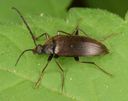Gonoderina
Gonoderina
Classification
- Phylum: Arthropoda
- Subphylum: Hexapoda
- Class: Insecta
- Order: Coleoptera
- Suborder: Polyphaga
- Superfamily: Tenebrionoidea
- Family: Tenebrionidae
- Subfamily: Alleculinae
- Subtribe: Gonoderina
Pronunciation
How to pronounce Gonoderina: /ɡoʊˈnɒdərɪnə/
These audio files are automatically generated. While they are not always 100% accurate, they are a good starting point.
Images






Summary
Gonoderina is a subtribe of comb-clawed beetles within the family Tenebrionidae, consisting of around 25 species in 7 genera in certain regions. The genus Capnochroa includes at least two known species, which are characterized by their detritivorous diet and unique claw structure.
Physical Characteristics
Comb-clawed beetles can be identified by their distinctive claws on their middle tarsi which resemble combs. Members of the Capnochroa genus typically have a dark coloration and elongated body shape.
Identification Tips
To identify Gonoderina, look for the unique claw structure on the legs, specifically the middle tarsi, which distinguishes them from other beetles. Additionally, observing their size and color may help in identifying specific species within the genus Capnochroa.
Habitat
Gonoderina beetles are commonly found in various habitats, including forests, fields, and decaying wood. They are often associated with environments rich in decaying organic material.
Distribution
The distribution of Capnochroa species is primarily in North America, with occurrence in various regions where their preferred habitats exist.
Diet
Capnochroa species are detritivores, primarily feeding on decaying organic matter, fungi, and dead plant material.
Life Cycle
Details regarding the life cycle of Gonoderina are not well documented but generally include an egg, larval, pupal, and adult stage.
Reproduction
Like many beetles, Gonoderina species reproduce by laying eggs in suitable habitats that provide food for the larvae upon hatching.
Ecosystem Role
Gonoderina beetles play an important role in the ecosystem as decomposers, helping to break down and recycle organic materials back into the soil.
Collecting Methods
- Hand collection from natural habitats
- Use of pitfall traps in suitable habitats
Preservation Methods
- Ethanol preservation
- Drying and pinning
Similar Taxa
- Other genera within the Tenebrionidae family
- Similar comb-clawed beetles
Tags
- Gonoderina
- Capnochroa
- comb-clawed beetles
- Tenebrionidae